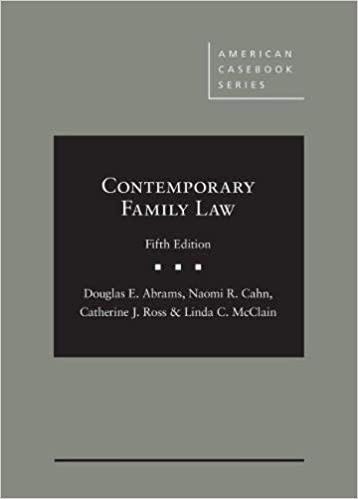Question
1.What are the main underlying (or unwritten) principles of the American Constitution? 2.To what does the Supreme Court's appellate jurisdiction refer? What are the three
1.What are the main underlying (or unwritten) principles of the American Constitution?
2.To what does the Supreme Court's appellate jurisdiction refer? What are the three categories into which it is divided?
3.How are appellants (or petitioners) to the Court distinct from appellees (or respondents)?
4.What is at stake in debates between legalism and realist interpretations of judicial decision making?
5.What is originalism? What are three arguments adduced by its advocates? What are three objections that can be raised against it?
6.What does it mean to study judicial decision making by stressin
g judicial "attitudes"? What are some drawbacks of this approach?
7.In what sense are supreme court justices "strategic actors"? Why might that fact support a
realistic interpretation of their decisions?
8.What "external factors" influence judicial decision
making? Explain how each one might affect a justice's jurisprudence.
9.What power did the Supreme Court claim for itself in
Marbury v. Madison? How did Justice John Marshall assert this power without inviting a backlash from the Jefferson Administration?
10.In Martin v. Hunter's Lessee, what rationale did the Court use to
justify striking down state laws and the rulings of state courts?
11.In which landmark case did the Supreme Court first consider whether Congress can
remove the Court's appellate jurisdiction as its discretion? How did the Court rule?
12.What does it mean for a case to be "justiciable"? Is justiciability a constraint on the Court? Why?
13.What is the judicial doctrine that begins with Luther v. Borden? What rule did the Court develop in Baker v. Carr for invoking it? In Baker, what was Justice Frankfurter's main objection in his dissent
14.How does the concept of "standing" constrain judicial power?
How is it at issue in Frothingham v. Mellon
And Flast v. Cohen?
15.What are two ways in which the separation of powers may constrain decisions made by the Supreme Court?
16.What were the two main controversies during the constitutional
convention pertaining to Article I, Sec. 8?
17.On what question was the Supreme Court asked to pronounce in
Powell v. McCormack?How is it related to the question at issue in
U.S. Term Limits, Inc. v. Thornton?
18.What is the Speech or Debate Clause and why
might the Framers have included it in
Article I? What are the two kinds of controversies that it has engendered
Step by Step Solution
There are 3 Steps involved in it
Step: 1

Get Instant Access to Expert-Tailored Solutions
See step-by-step solutions with expert insights and AI powered tools for academic success
Step: 2

Step: 3

Ace Your Homework with AI
Get the answers you need in no time with our AI-driven, step-by-step assistance
Get Started


